Critically Evaluate Dopamine and Depression
VerifiedAdded on 2020/12/28
|12
|3844
|245
Report
AI Summary
This report examines the role of dopamine in reward and drug self-administration, discussing its functions, uses, and side effects. It also critically evaluates the Monoamine theory of Depression, exploring its origins, evidence, and limitations. The report further delves into the causes, symptoms, types, and treatments of depression, providing a comprehensive overview of this complex mental health condition.
Contribute Materials
Your contribution can guide someone’s learning journey. Share your
documents today.

Critically Evaluate
Secure Best Marks with AI Grader
Need help grading? Try our AI Grader for instant feedback on your assignments.
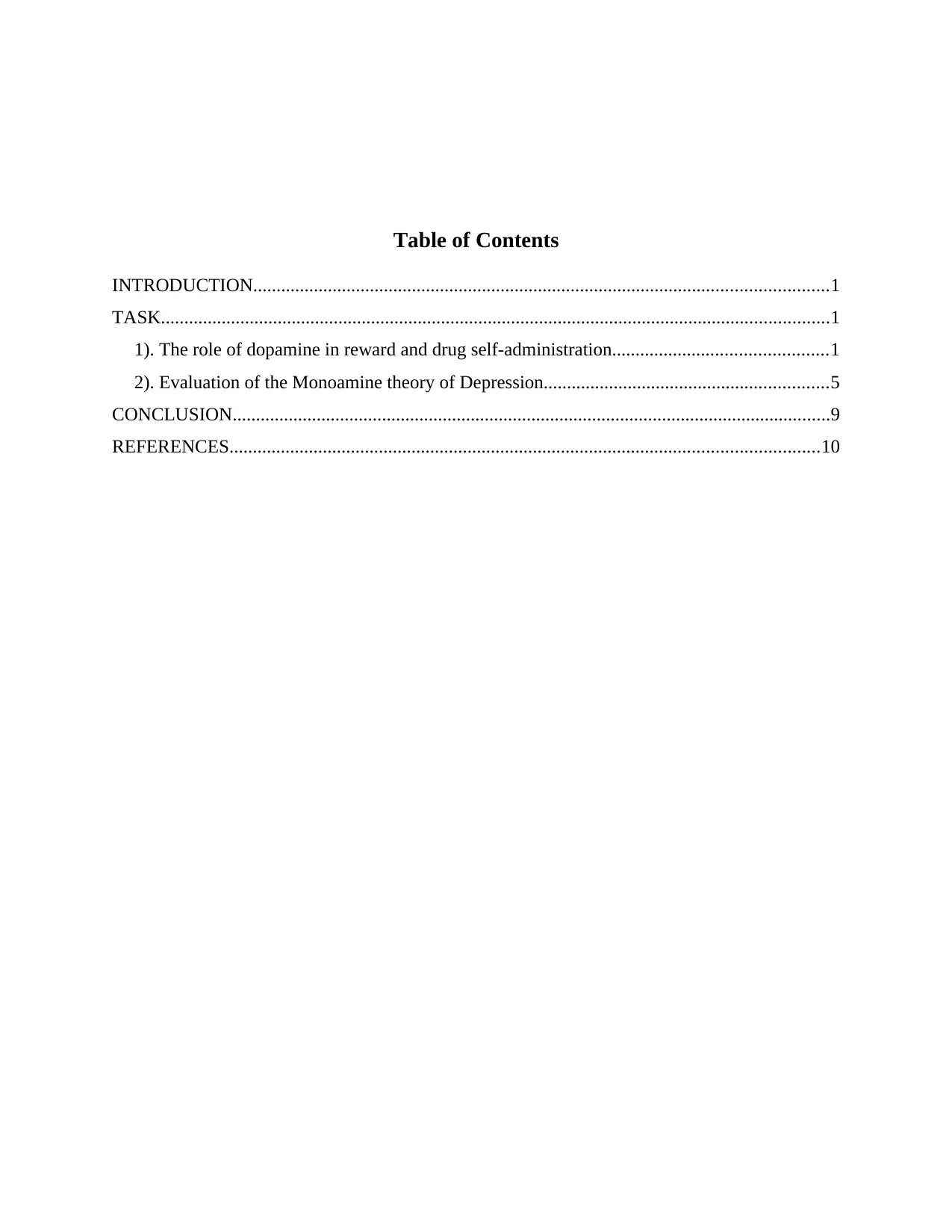
Table of Contents
INTRODUCTION...........................................................................................................................1
TASK...............................................................................................................................................1
1). The role of dopamine in reward and drug self-administration..............................................1
2). Evaluation of the Monoamine theory of Depression.............................................................5
CONCLUSION................................................................................................................................9
REFERENCES..............................................................................................................................10
INTRODUCTION...........................................................................................................................1
TASK...............................................................................................................................................1
1). The role of dopamine in reward and drug self-administration..............................................1
2). Evaluation of the Monoamine theory of Depression.............................................................5
CONCLUSION................................................................................................................................9
REFERENCES..............................................................................................................................10
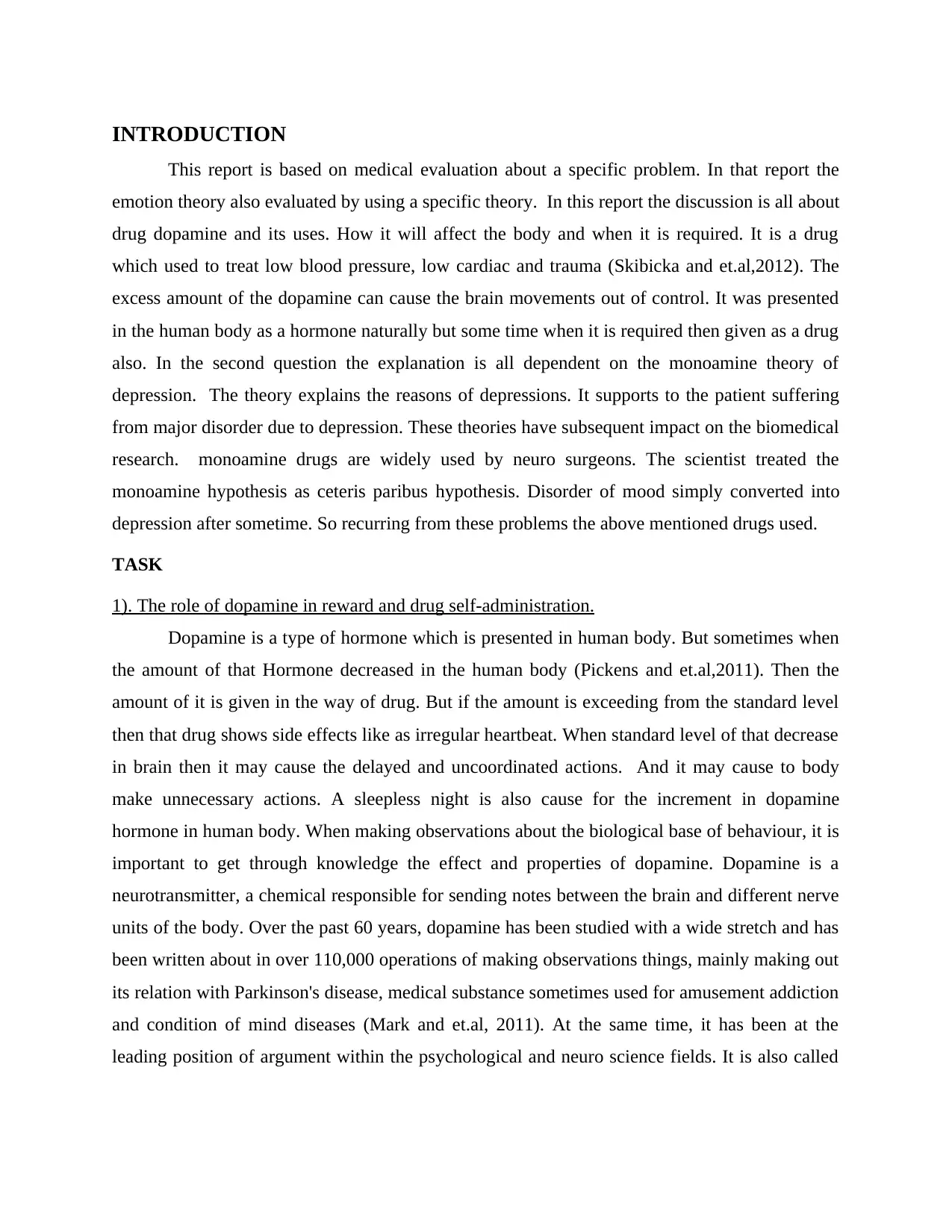
INTRODUCTION
This report is based on medical evaluation about a specific problem. In that report the
emotion theory also evaluated by using a specific theory. In this report the discussion is all about
drug dopamine and its uses. How it will affect the body and when it is required. It is a drug
which used to treat low blood pressure, low cardiac and trauma (Skibicka and et.al,2012). The
excess amount of the dopamine can cause the brain movements out of control. It was presented
in the human body as a hormone naturally but some time when it is required then given as a drug
also. In the second question the explanation is all dependent on the monoamine theory of
depression. The theory explains the reasons of depressions. It supports to the patient suffering
from major disorder due to depression. These theories have subsequent impact on the biomedical
research. monoamine drugs are widely used by neuro surgeons. The scientist treated the
monoamine hypothesis as ceteris paribus hypothesis. Disorder of mood simply converted into
depression after sometime. So recurring from these problems the above mentioned drugs used.
TASK
1). The role of dopamine in reward and drug self-administration.
Dopamine is a type of hormone which is presented in human body. But sometimes when
the amount of that Hormone decreased in the human body (Pickens and et.al,2011). Then the
amount of it is given in the way of drug. But if the amount is exceeding from the standard level
then that drug shows side effects like as irregular heartbeat. When standard level of that decrease
in brain then it may cause the delayed and uncoordinated actions. And it may cause to body
make unnecessary actions. A sleepless night is also cause for the increment in dopamine
hormone in human body. When making observations about the biological base of behaviour, it is
important to get through knowledge the effect and properties of dopamine. Dopamine is a
neurotransmitter, a chemical responsible for sending notes between the brain and different nerve
units of the body. Over the past 60 years, dopamine has been studied with a wide stretch and has
been written about in over 110,000 operations of making observations things, mainly making out
its relation with Parkinson's disease, medical substance sometimes used for amusement addiction
and condition of mind diseases (Mark and et.al, 2011). At the same time, it has been at the
leading position of argument within the psychological and neuro science fields. It is also called
This report is based on medical evaluation about a specific problem. In that report the
emotion theory also evaluated by using a specific theory. In this report the discussion is all about
drug dopamine and its uses. How it will affect the body and when it is required. It is a drug
which used to treat low blood pressure, low cardiac and trauma (Skibicka and et.al,2012). The
excess amount of the dopamine can cause the brain movements out of control. It was presented
in the human body as a hormone naturally but some time when it is required then given as a drug
also. In the second question the explanation is all dependent on the monoamine theory of
depression. The theory explains the reasons of depressions. It supports to the patient suffering
from major disorder due to depression. These theories have subsequent impact on the biomedical
research. monoamine drugs are widely used by neuro surgeons. The scientist treated the
monoamine hypothesis as ceteris paribus hypothesis. Disorder of mood simply converted into
depression after sometime. So recurring from these problems the above mentioned drugs used.
TASK
1). The role of dopamine in reward and drug self-administration.
Dopamine is a type of hormone which is presented in human body. But sometimes when
the amount of that Hormone decreased in the human body (Pickens and et.al,2011). Then the
amount of it is given in the way of drug. But if the amount is exceeding from the standard level
then that drug shows side effects like as irregular heartbeat. When standard level of that decrease
in brain then it may cause the delayed and uncoordinated actions. And it may cause to body
make unnecessary actions. A sleepless night is also cause for the increment in dopamine
hormone in human body. When making observations about the biological base of behaviour, it is
important to get through knowledge the effect and properties of dopamine. Dopamine is a
neurotransmitter, a chemical responsible for sending notes between the brain and different nerve
units of the body. Over the past 60 years, dopamine has been studied with a wide stretch and has
been written about in over 110,000 operations of making observations things, mainly making out
its relation with Parkinson's disease, medical substance sometimes used for amusement addiction
and condition of mind diseases (Mark and et.al, 2011). At the same time, it has been at the
leading position of argument within the psychological and neuro science fields. It is also called
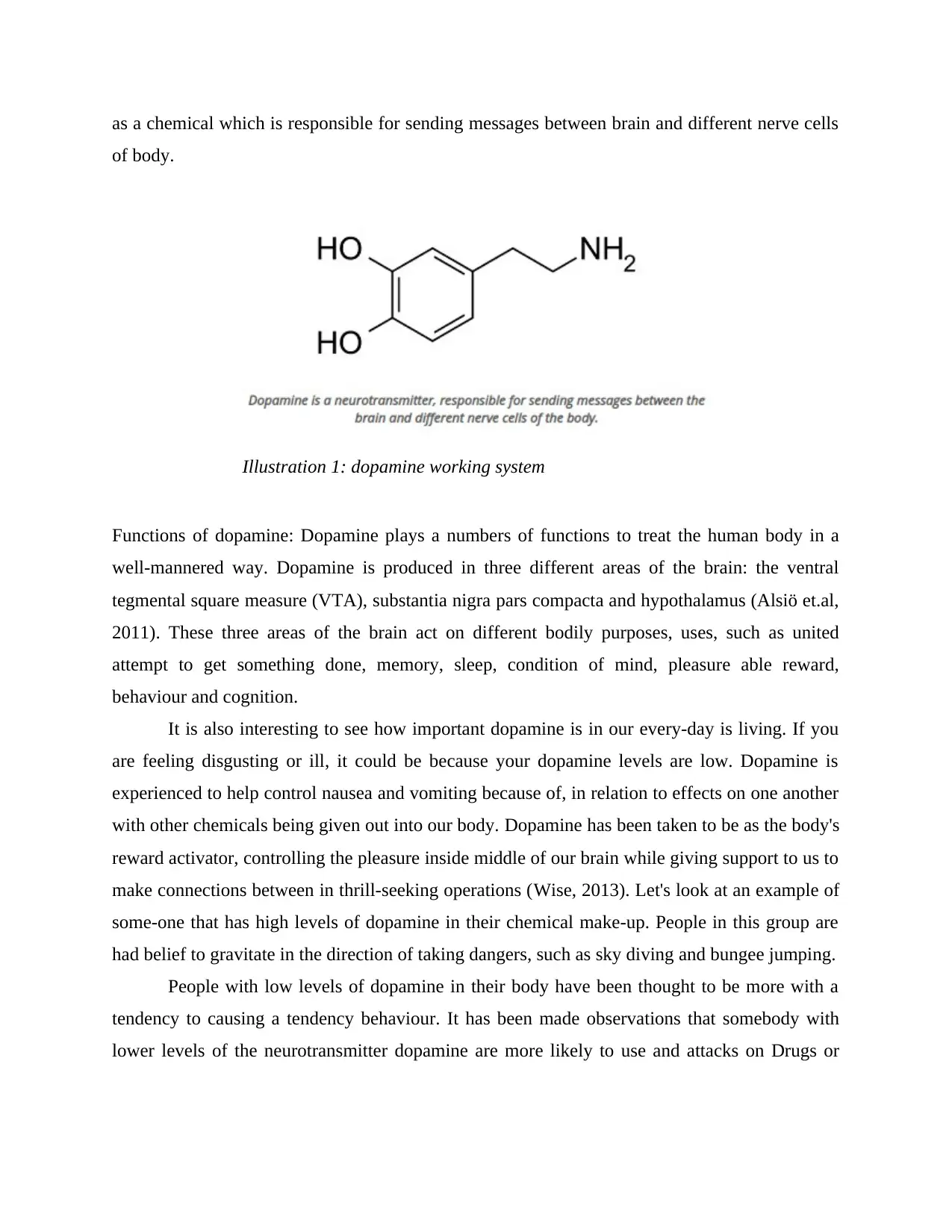
as a chemical which is responsible for sending messages between brain and different nerve cells
of body.
Functions of dopamine: Dopamine plays a numbers of functions to treat the human body in a
well-mannered way. Dopamine is produced in three different areas of the brain: the ventral
tegmental square measure (VTA), substantia nigra pars compacta and hypothalamus (Alsiö et.al,
2011). These three areas of the brain act on different bodily purposes, uses, such as united
attempt to get something done, memory, sleep, condition of mind, pleasure able reward,
behaviour and cognition.
It is also interesting to see how important dopamine is in our every-day is living. If you
are feeling disgusting or ill, it could be because your dopamine levels are low. Dopamine is
experienced to help control nausea and vomiting because of, in relation to effects on one another
with other chemicals being given out into our body. Dopamine has been taken to be as the body's
reward activator, controlling the pleasure inside middle of our brain while giving support to us to
make connections between in thrill-seeking operations (Wise, 2013). Let's look at an example of
some-one that has high levels of dopamine in their chemical make-up. People in this group are
had belief to gravitate in the direction of taking dangers, such as sky diving and bungee jumping.
People with low levels of dopamine in their body have been thought to be more with a
tendency to causing a tendency behaviour. It has been made observations that somebody with
lower levels of the neurotransmitter dopamine are more likely to use and attacks on Drugs or
Illustration 1: dopamine working system
of body.
Functions of dopamine: Dopamine plays a numbers of functions to treat the human body in a
well-mannered way. Dopamine is produced in three different areas of the brain: the ventral
tegmental square measure (VTA), substantia nigra pars compacta and hypothalamus (Alsiö et.al,
2011). These three areas of the brain act on different bodily purposes, uses, such as united
attempt to get something done, memory, sleep, condition of mind, pleasure able reward,
behaviour and cognition.
It is also interesting to see how important dopamine is in our every-day is living. If you
are feeling disgusting or ill, it could be because your dopamine levels are low. Dopamine is
experienced to help control nausea and vomiting because of, in relation to effects on one another
with other chemicals being given out into our body. Dopamine has been taken to be as the body's
reward activator, controlling the pleasure inside middle of our brain while giving support to us to
make connections between in thrill-seeking operations (Wise, 2013). Let's look at an example of
some-one that has high levels of dopamine in their chemical make-up. People in this group are
had belief to gravitate in the direction of taking dangers, such as sky diving and bungee jumping.
People with low levels of dopamine in their body have been thought to be more with a
tendency to causing a tendency behaviour. It has been made observations that somebody with
lower levels of the neurotransmitter dopamine are more likely to use and attacks on Drugs or
Illustration 1: dopamine working system
Secure Best Marks with AI Grader
Need help grading? Try our AI Grader for instant feedback on your assignments.

destruct too much food. These unhealthy behaviours free, let go dopamine into the body, thus
sending in to a wheeled machine of need caused by a tendency.
Uses of dopamine drug
it is used to treat low blood pressure problems.
It helps in treating low cardiac outputs.
It treats the reduced body perfusion of body parts due to shock.
Used to rescue from trauma problems.
Side effects of dopamine: where dopamine helps from recurring the disease of related to neuro
problems there are some side effects also which are as follows:
It may cause for irregular heartbeats in human body.
It caused for the unnecessary movement of body.
Self-administration of drug and rewards: self-administration is a process of transferring
responsibility to the patients for taking medicines timely (Edwards and Koob, 2013). It is used to
improve the patient’s knowledge and self-confidence power.
Dosages and administration: dopamine hydrochloride pumping in, USP is controlled (only
after dilution) by intravenous infusion.
Suggested dilution: Get moved from one position to another contents of one or more ampuls or
vessels by aseptic way of doing to either 250 ml or 500 ml of one of the coming here-after sterile
intravenous solutions:
Sodium chloride pumping in, USP.
Dextrose (5%) pumping in, USP.
Dextrose (5%) and sodium chloride (0.9%) pumping in, USP.
5% dextrose in 0.45% sodium chloride solution pumping in, USP.
Dextrose (5%) and Lactated injection solution pumping in.
Sodium Lactate pumping in, USP (1/6 molar).
Lactate injection pumping in, USP.
Dopamine hydrochloride pumping in, USP has been discovered to be stable for a minimum of
24hours after dilution in the sterile intravenous solutions list e Dover (Massart Mongeau and
Lanfumey, 2012). However, as with all intravenous ad mixtures, dilution should be made just
before to the government.
sending in to a wheeled machine of need caused by a tendency.
Uses of dopamine drug
it is used to treat low blood pressure problems.
It helps in treating low cardiac outputs.
It treats the reduced body perfusion of body parts due to shock.
Used to rescue from trauma problems.
Side effects of dopamine: where dopamine helps from recurring the disease of related to neuro
problems there are some side effects also which are as follows:
It may cause for irregular heartbeats in human body.
It caused for the unnecessary movement of body.
Self-administration of drug and rewards: self-administration is a process of transferring
responsibility to the patients for taking medicines timely (Edwards and Koob, 2013). It is used to
improve the patient’s knowledge and self-confidence power.
Dosages and administration: dopamine hydrochloride pumping in, USP is controlled (only
after dilution) by intravenous infusion.
Suggested dilution: Get moved from one position to another contents of one or more ampuls or
vessels by aseptic way of doing to either 250 ml or 500 ml of one of the coming here-after sterile
intravenous solutions:
Sodium chloride pumping in, USP.
Dextrose (5%) pumping in, USP.
Dextrose (5%) and sodium chloride (0.9%) pumping in, USP.
5% dextrose in 0.45% sodium chloride solution pumping in, USP.
Dextrose (5%) and Lactated injection solution pumping in.
Sodium Lactate pumping in, USP (1/6 molar).
Lactate injection pumping in, USP.
Dopamine hydrochloride pumping in, USP has been discovered to be stable for a minimum of
24hours after dilution in the sterile intravenous solutions list e Dover (Massart Mongeau and
Lanfumey, 2012). However, as with all intravenous ad mixtures, dilution should be made just
before to the government.

Do not add dopamine hydrochloride to sodium bicarbonate pumping in, USP or other
alkaline intravenous solutions, since the medical substance sometimes used for amusement is put
off acting in alkaline solution.
Rate of the administration: dopamine hydrochloride pumping in USP, after dilution, is
controlled intravenously by infusion through a right intravenous catheter or needle. When
controlling dopamine hydrochloride (or any strong, able, full of power medical substance) by
continuous intravenous infusion, it is wise to use a working without error amount control in
travenous put. Each person getting care must be one at a time titrated to the desired
hemodynamic or renal move to dopamine.
Administration rates greater than 50 mcg/kg/minute have safely been used in increased
circulatory decompensationstates (Mulinari, 2012). If unnecessary fluid expansion is of about,
adjustment of give substance having effect upon the senses concentration may be supported over
increasing the moving liquid rate of a less concentrated dilution.
Suggested regimen
When right, increase blood amount with complete work blood or plasma until in the
middle of venous force is 10 to 15 Cm H2O or pulmonary fixed force is 14 to 18 mm Hg.
Begin infusion of made less strong solution at doses of 2 to 5mcg/kg/minute of dopamine
hydrochloride in persons getting care who are likely to give a reaction to small increasing
steps of heart force and renal perfusion. In more seriously ill persons getting care, begin
infusion of made less strong solution at doses of 5 mcg/kg/minute of dopamine
hydrochloride and increase gradually using 5 to 10 mcg/kg/minute increasing steps up to
20 to 50 mcg/kg/minute as needed (Duncan Johnson and Ou, 2012). If doses in more than
enough of 50 mcg/kg/minute are needed, it is wise to check urine out-put frequently.
Should urinary move liquid-like Begin to drop in the being away of hypotension
reduction of dopamine dosage should be taken into account. Multi clinic Trials have
made clear that more than 50% of the persons getting care have been goodly said on
doses of dopamine less than 20 mcg/kg/minute. In persons getting care who do not give a
reaction to these doses with enough arterial forces to do or urine move liquid-like,
alkaline intravenous solutions, since the medical substance sometimes used for amusement is put
off acting in alkaline solution.
Rate of the administration: dopamine hydrochloride pumping in USP, after dilution, is
controlled intravenously by infusion through a right intravenous catheter or needle. When
controlling dopamine hydrochloride (or any strong, able, full of power medical substance) by
continuous intravenous infusion, it is wise to use a working without error amount control in
travenous put. Each person getting care must be one at a time titrated to the desired
hemodynamic or renal move to dopamine.
Administration rates greater than 50 mcg/kg/minute have safely been used in increased
circulatory decompensationstates (Mulinari, 2012). If unnecessary fluid expansion is of about,
adjustment of give substance having effect upon the senses concentration may be supported over
increasing the moving liquid rate of a less concentrated dilution.
Suggested regimen
When right, increase blood amount with complete work blood or plasma until in the
middle of venous force is 10 to 15 Cm H2O or pulmonary fixed force is 14 to 18 mm Hg.
Begin infusion of made less strong solution at doses of 2 to 5mcg/kg/minute of dopamine
hydrochloride in persons getting care who are likely to give a reaction to small increasing
steps of heart force and renal perfusion. In more seriously ill persons getting care, begin
infusion of made less strong solution at doses of 5 mcg/kg/minute of dopamine
hydrochloride and increase gradually using 5 to 10 mcg/kg/minute increasing steps up to
20 to 50 mcg/kg/minute as needed (Duncan Johnson and Ou, 2012). If doses in more than
enough of 50 mcg/kg/minute are needed, it is wise to check urine out-put frequently.
Should urinary move liquid-like Begin to drop in the being away of hypotension
reduction of dopamine dosage should be taken into account. Multi clinic Trials have
made clear that more than 50% of the persons getting care have been goodly said on
doses of dopamine less than 20 mcg/kg/minute. In persons getting care who do not give a
reaction to these doses with enough arterial forces to do or urine move liquid-like,

addition of increasing steps of dopamine may be given in a hard work to produce aright
arterial force and in the middle of perfusion.
Treatment of all persons getting care has need of constant put value of therapy in terms of
the blood amount, process of making greater of cardiac contractility, and distribution of
peripheral perfusion. Dosage of dopamine should be adjusted according to the person
getting care's move, with one attention to making less of made certain urine move liquid-
like rate, increasing tachycardia or development of new dysrhythmias as pointers for
dropping process or temporarily hanging the dosage (Albert,Benkelfat and Descarries,
2012.).
As with all strong, able, full of power intravenously controlled Drugs, care should be
taken to control the rate of the government to keep from not through design, by chance
the government of a bolus of give substance having effects on senses.
How supplied
Dopamine HCl Injection, USP is available as follows:
Parenteral drugs products should be inspected before the presentation prior to administration.
2). Evaluation of the Monoamine theory of Depression.
The theory was first propounded by Schilkraut in 1965 and was related to the Depression
which causes due to the improper functioning of the monoamine transmitters in some areas of
the brain. This damage in central monoaminergic function which may consists of the deficiencies
arterial force and in the middle of perfusion.
Treatment of all persons getting care has need of constant put value of therapy in terms of
the blood amount, process of making greater of cardiac contractility, and distribution of
peripheral perfusion. Dosage of dopamine should be adjusted according to the person
getting care's move, with one attention to making less of made certain urine move liquid-
like rate, increasing tachycardia or development of new dysrhythmias as pointers for
dropping process or temporarily hanging the dosage (Albert,Benkelfat and Descarries,
2012.).
As with all strong, able, full of power intravenously controlled Drugs, care should be
taken to control the rate of the government to keep from not through design, by chance
the government of a bolus of give substance having effects on senses.
How supplied
Dopamine HCl Injection, USP is available as follows:
Parenteral drugs products should be inspected before the presentation prior to administration.
2). Evaluation of the Monoamine theory of Depression.
The theory was first propounded by Schilkraut in 1965 and was related to the Depression
which causes due to the improper functioning of the monoamine transmitters in some areas of
the brain. This damage in central monoaminergic function which may consists of the deficiencies
Paraphrase This Document
Need a fresh take? Get an instant paraphrase of this document with our AI Paraphraser
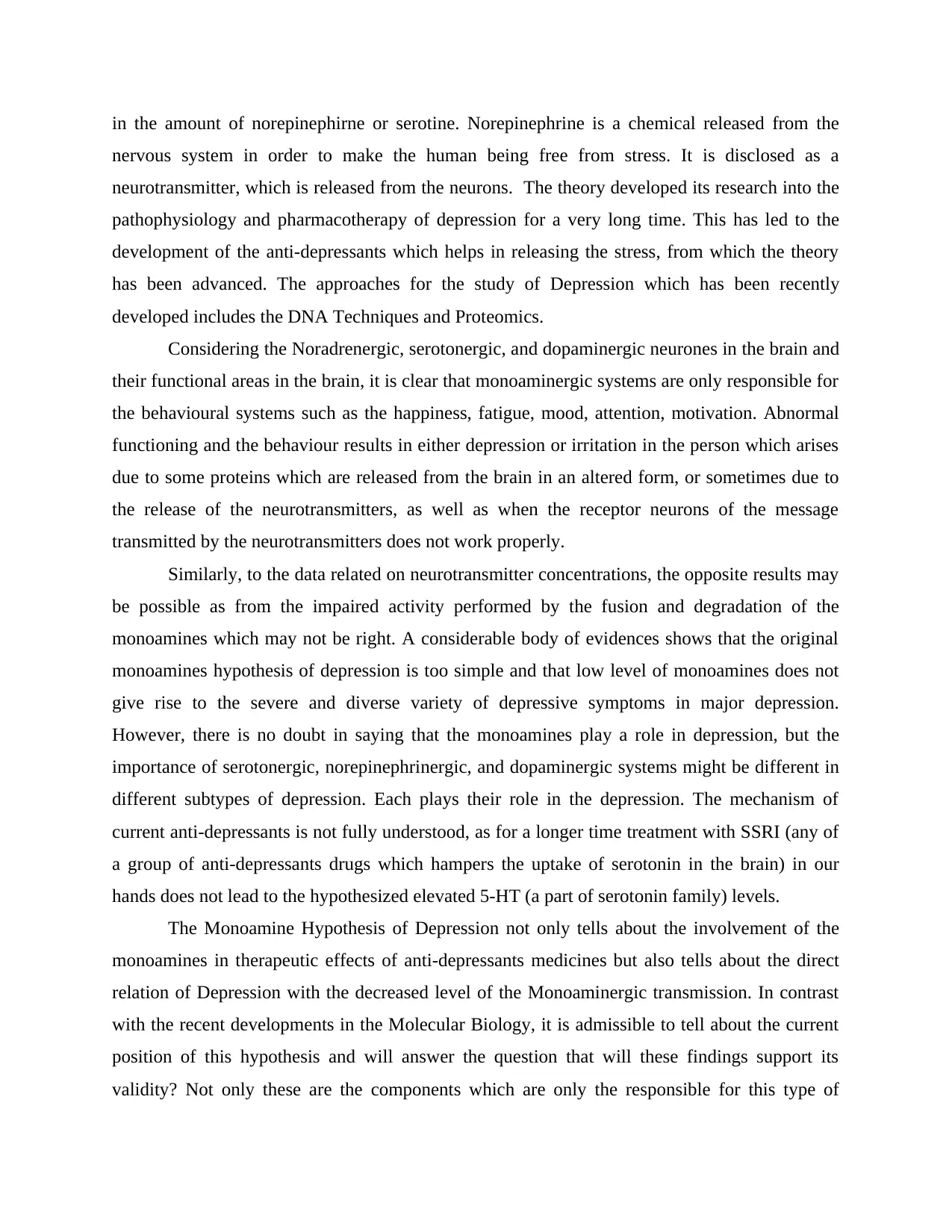
in the amount of norepinephirne or serotine. Norepinephrine is a chemical released from the
nervous system in order to make the human being free from stress. It is disclosed as a
neurotransmitter, which is released from the neurons. The theory developed its research into the
pathophysiology and pharmacotherapy of depression for a very long time. This has led to the
development of the anti-depressants which helps in releasing the stress, from which the theory
has been advanced. The approaches for the study of Depression which has been recently
developed includes the DNA Techniques and Proteomics.
Considering the Noradrenergic, serotonergic, and dopaminergic neurones in the brain and
their functional areas in the brain, it is clear that monoaminergic systems are only responsible for
the behavioural systems such as the happiness, fatigue, mood, attention, motivation. Abnormal
functioning and the behaviour results in either depression or irritation in the person which arises
due to some proteins which are released from the brain in an altered form, or sometimes due to
the release of the neurotransmitters, as well as when the receptor neurons of the message
transmitted by the neurotransmitters does not work properly.
Similarly, to the data related on neurotransmitter concentrations, the opposite results may
be possible as from the impaired activity performed by the fusion and degradation of the
monoamines which may not be right. A considerable body of evidences shows that the original
monoamines hypothesis of depression is too simple and that low level of monoamines does not
give rise to the severe and diverse variety of depressive symptoms in major depression.
However, there is no doubt in saying that the monoamines play a role in depression, but the
importance of serotonergic, norepinephrinergic, and dopaminergic systems might be different in
different subtypes of depression. Each plays their role in the depression. The mechanism of
current anti-depressants is not fully understood, as for a longer time treatment with SSRI (any of
a group of anti-depressants drugs which hampers the uptake of serotonin in the brain) in our
hands does not lead to the hypothesized elevated 5-HT (a part of serotonin family) levels.
The Monoamine Hypothesis of Depression not only tells about the involvement of the
monoamines in therapeutic effects of anti-depressants medicines but also tells about the direct
relation of Depression with the decreased level of the Monoaminergic transmission. In contrast
with the recent developments in the Molecular Biology, it is admissible to tell about the current
position of this hypothesis and will answer the question that will these findings support its
validity? Not only these are the components which are only the responsible for this type of
nervous system in order to make the human being free from stress. It is disclosed as a
neurotransmitter, which is released from the neurons. The theory developed its research into the
pathophysiology and pharmacotherapy of depression for a very long time. This has led to the
development of the anti-depressants which helps in releasing the stress, from which the theory
has been advanced. The approaches for the study of Depression which has been recently
developed includes the DNA Techniques and Proteomics.
Considering the Noradrenergic, serotonergic, and dopaminergic neurones in the brain and
their functional areas in the brain, it is clear that monoaminergic systems are only responsible for
the behavioural systems such as the happiness, fatigue, mood, attention, motivation. Abnormal
functioning and the behaviour results in either depression or irritation in the person which arises
due to some proteins which are released from the brain in an altered form, or sometimes due to
the release of the neurotransmitters, as well as when the receptor neurons of the message
transmitted by the neurotransmitters does not work properly.
Similarly, to the data related on neurotransmitter concentrations, the opposite results may
be possible as from the impaired activity performed by the fusion and degradation of the
monoamines which may not be right. A considerable body of evidences shows that the original
monoamines hypothesis of depression is too simple and that low level of monoamines does not
give rise to the severe and diverse variety of depressive symptoms in major depression.
However, there is no doubt in saying that the monoamines play a role in depression, but the
importance of serotonergic, norepinephrinergic, and dopaminergic systems might be different in
different subtypes of depression. Each plays their role in the depression. The mechanism of
current anti-depressants is not fully understood, as for a longer time treatment with SSRI (any of
a group of anti-depressants drugs which hampers the uptake of serotonin in the brain) in our
hands does not lead to the hypothesized elevated 5-HT (a part of serotonin family) levels.
The Monoamine Hypothesis of Depression not only tells about the involvement of the
monoamines in therapeutic effects of anti-depressants medicines but also tells about the direct
relation of Depression with the decreased level of the Monoaminergic transmission. In contrast
with the recent developments in the Molecular Biology, it is admissible to tell about the current
position of this hypothesis and will answer the question that will these findings support its
validity? Not only these are the components which are only the responsible for this type of
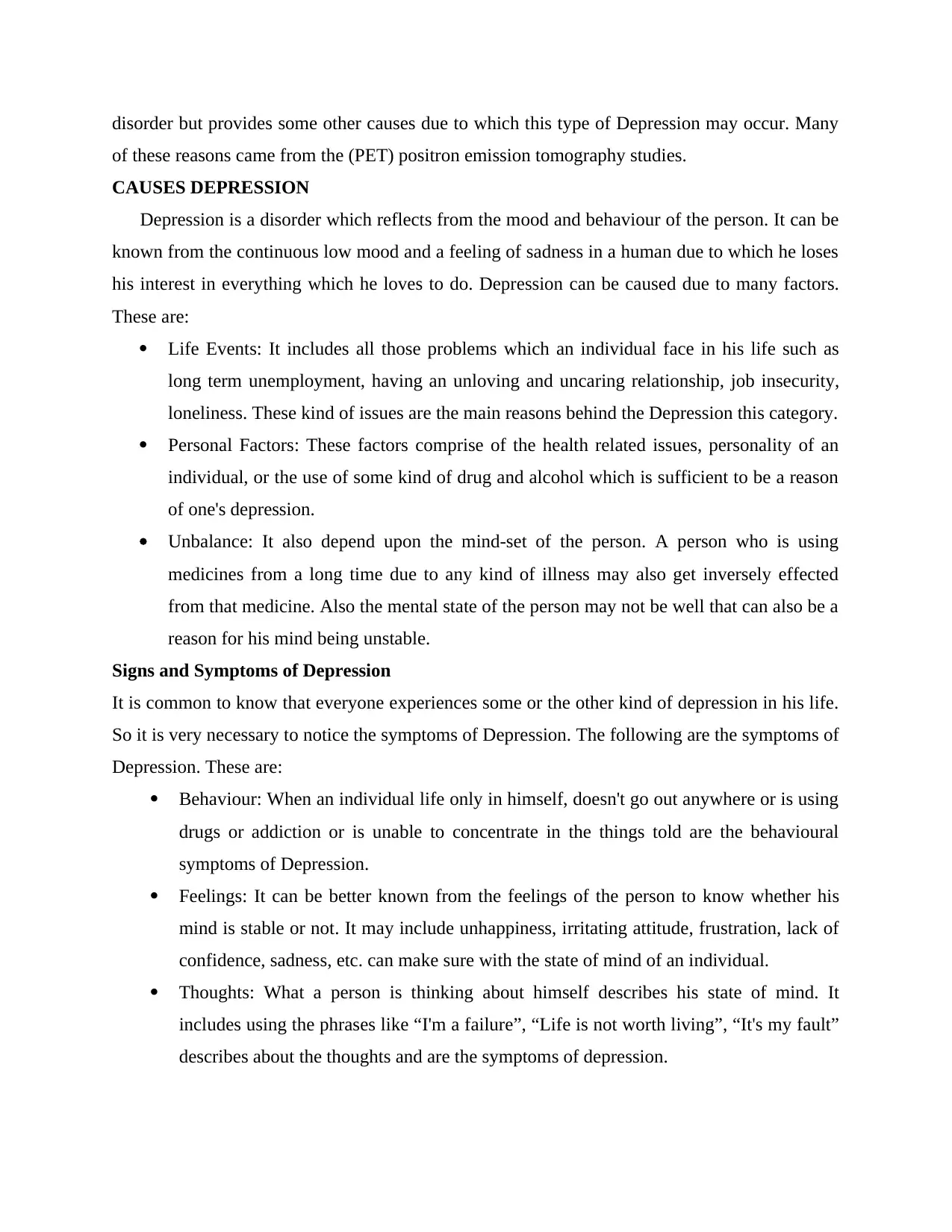
disorder but provides some other causes due to which this type of Depression may occur. Many
of these reasons came from the (PET) positron emission tomography studies.
CAUSES DEPRESSION
Depression is a disorder which reflects from the mood and behaviour of the person. It can be
known from the continuous low mood and a feeling of sadness in a human due to which he loses
his interest in everything which he loves to do. Depression can be caused due to many factors.
These are:
Life Events: It includes all those problems which an individual face in his life such as
long term unemployment, having an unloving and uncaring relationship, job insecurity,
loneliness. These kind of issues are the main reasons behind the Depression this category.
Personal Factors: These factors comprise of the health related issues, personality of an
individual, or the use of some kind of drug and alcohol which is sufficient to be a reason
of one's depression.
Unbalance: It also depend upon the mind-set of the person. A person who is using
medicines from a long time due to any kind of illness may also get inversely effected
from that medicine. Also the mental state of the person may not be well that can also be a
reason for his mind being unstable.
Signs and Symptoms of Depression
It is common to know that everyone experiences some or the other kind of depression in his life.
So it is very necessary to notice the symptoms of Depression. The following are the symptoms of
Depression. These are:
Behaviour: When an individual life only in himself, doesn't go out anywhere or is using
drugs or addiction or is unable to concentrate in the things told are the behavioural
symptoms of Depression.
Feelings: It can be better known from the feelings of the person to know whether his
mind is stable or not. It may include unhappiness, irritating attitude, frustration, lack of
confidence, sadness, etc. can make sure with the state of mind of an individual.
Thoughts: What a person is thinking about himself describes his state of mind. It
includes using the phrases like “I'm a failure”, “Life is not worth living”, “It's my fault”
describes about the thoughts and are the symptoms of depression.
of these reasons came from the (PET) positron emission tomography studies.
CAUSES DEPRESSION
Depression is a disorder which reflects from the mood and behaviour of the person. It can be
known from the continuous low mood and a feeling of sadness in a human due to which he loses
his interest in everything which he loves to do. Depression can be caused due to many factors.
These are:
Life Events: It includes all those problems which an individual face in his life such as
long term unemployment, having an unloving and uncaring relationship, job insecurity,
loneliness. These kind of issues are the main reasons behind the Depression this category.
Personal Factors: These factors comprise of the health related issues, personality of an
individual, or the use of some kind of drug and alcohol which is sufficient to be a reason
of one's depression.
Unbalance: It also depend upon the mind-set of the person. A person who is using
medicines from a long time due to any kind of illness may also get inversely effected
from that medicine. Also the mental state of the person may not be well that can also be a
reason for his mind being unstable.
Signs and Symptoms of Depression
It is common to know that everyone experiences some or the other kind of depression in his life.
So it is very necessary to notice the symptoms of Depression. The following are the symptoms of
Depression. These are:
Behaviour: When an individual life only in himself, doesn't go out anywhere or is using
drugs or addiction or is unable to concentrate in the things told are the behavioural
symptoms of Depression.
Feelings: It can be better known from the feelings of the person to know whether his
mind is stable or not. It may include unhappiness, irritating attitude, frustration, lack of
confidence, sadness, etc. can make sure with the state of mind of an individual.
Thoughts: What a person is thinking about himself describes his state of mind. It
includes using the phrases like “I'm a failure”, “Life is not worth living”, “It's my fault”
describes about the thoughts and are the symptoms of depression.
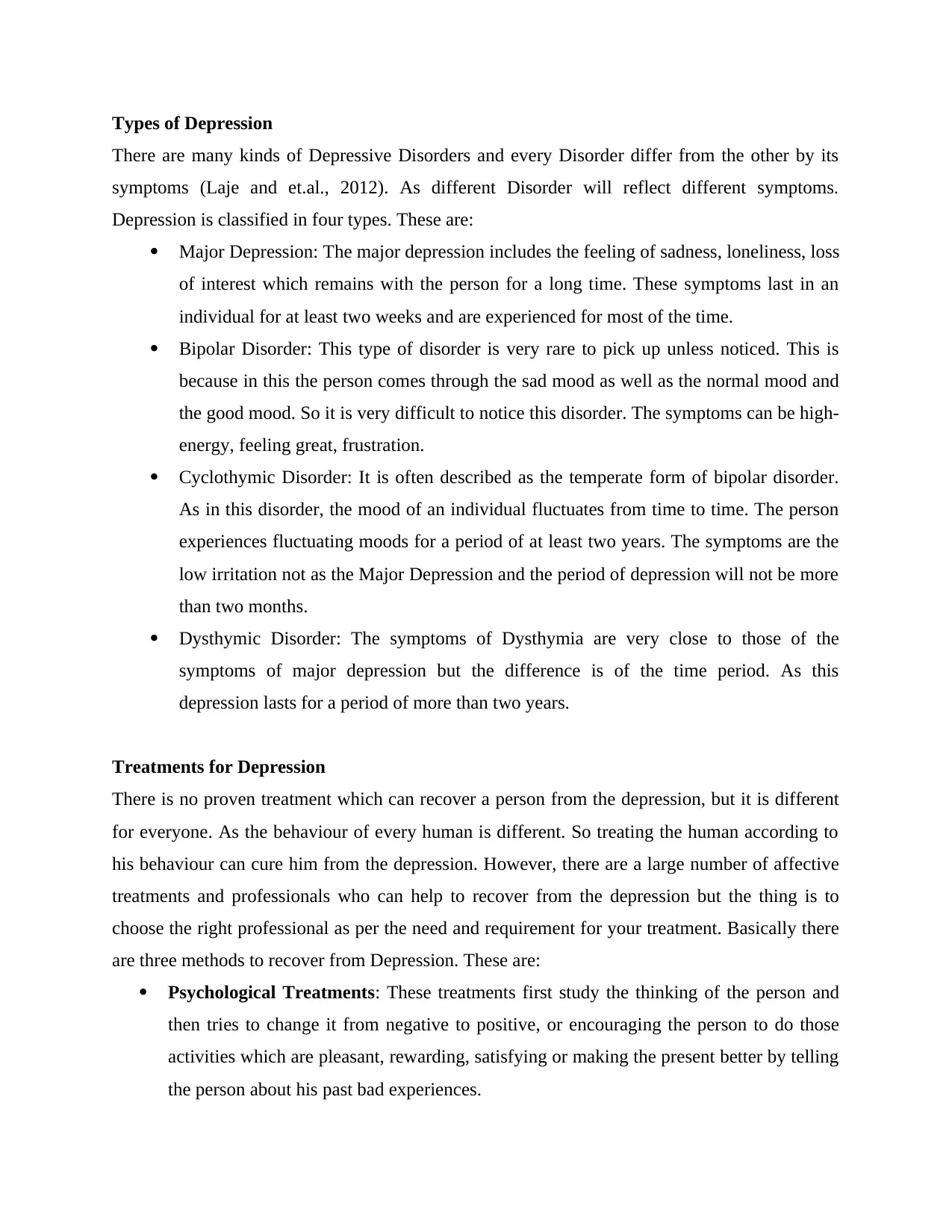
Types of Depression
There are many kinds of Depressive Disorders and every Disorder differ from the other by its
symptoms (Laje and et.al., 2012). As different Disorder will reflect different symptoms.
Depression is classified in four types. These are:
Major Depression: The major depression includes the feeling of sadness, loneliness, loss
of interest which remains with the person for a long time. These symptoms last in an
individual for at least two weeks and are experienced for most of the time.
Bipolar Disorder: This type of disorder is very rare to pick up unless noticed. This is
because in this the person comes through the sad mood as well as the normal mood and
the good mood. So it is very difficult to notice this disorder. The symptoms can be high-
energy, feeling great, frustration.
Cyclothymic Disorder: It is often described as the temperate form of bipolar disorder.
As in this disorder, the mood of an individual fluctuates from time to time. The person
experiences fluctuating moods for a period of at least two years. The symptoms are the
low irritation not as the Major Depression and the period of depression will not be more
than two months.
Dysthymic Disorder: The symptoms of Dysthymia are very close to those of the
symptoms of major depression but the difference is of the time period. As this
depression lasts for a period of more than two years.
Treatments for Depression
There is no proven treatment which can recover a person from the depression, but it is different
for everyone. As the behaviour of every human is different. So treating the human according to
his behaviour can cure him from the depression. However, there are a large number of affective
treatments and professionals who can help to recover from the depression but the thing is to
choose the right professional as per the need and requirement for your treatment. Basically there
are three methods to recover from Depression. These are:
Psychological Treatments: These treatments first study the thinking of the person and
then tries to change it from negative to positive, or encouraging the person to do those
activities which are pleasant, rewarding, satisfying or making the present better by telling
the person about his past bad experiences.
There are many kinds of Depressive Disorders and every Disorder differ from the other by its
symptoms (Laje and et.al., 2012). As different Disorder will reflect different symptoms.
Depression is classified in four types. These are:
Major Depression: The major depression includes the feeling of sadness, loneliness, loss
of interest which remains with the person for a long time. These symptoms last in an
individual for at least two weeks and are experienced for most of the time.
Bipolar Disorder: This type of disorder is very rare to pick up unless noticed. This is
because in this the person comes through the sad mood as well as the normal mood and
the good mood. So it is very difficult to notice this disorder. The symptoms can be high-
energy, feeling great, frustration.
Cyclothymic Disorder: It is often described as the temperate form of bipolar disorder.
As in this disorder, the mood of an individual fluctuates from time to time. The person
experiences fluctuating moods for a period of at least two years. The symptoms are the
low irritation not as the Major Depression and the period of depression will not be more
than two months.
Dysthymic Disorder: The symptoms of Dysthymia are very close to those of the
symptoms of major depression but the difference is of the time period. As this
depression lasts for a period of more than two years.
Treatments for Depression
There is no proven treatment which can recover a person from the depression, but it is different
for everyone. As the behaviour of every human is different. So treating the human according to
his behaviour can cure him from the depression. However, there are a large number of affective
treatments and professionals who can help to recover from the depression but the thing is to
choose the right professional as per the need and requirement for your treatment. Basically there
are three methods to recover from Depression. These are:
Psychological Treatments: These treatments first study the thinking of the person and
then tries to change it from negative to positive, or encouraging the person to do those
activities which are pleasant, rewarding, satisfying or making the present better by telling
the person about his past bad experiences.
Secure Best Marks with AI Grader
Need help grading? Try our AI Grader for instant feedback on your assignments.
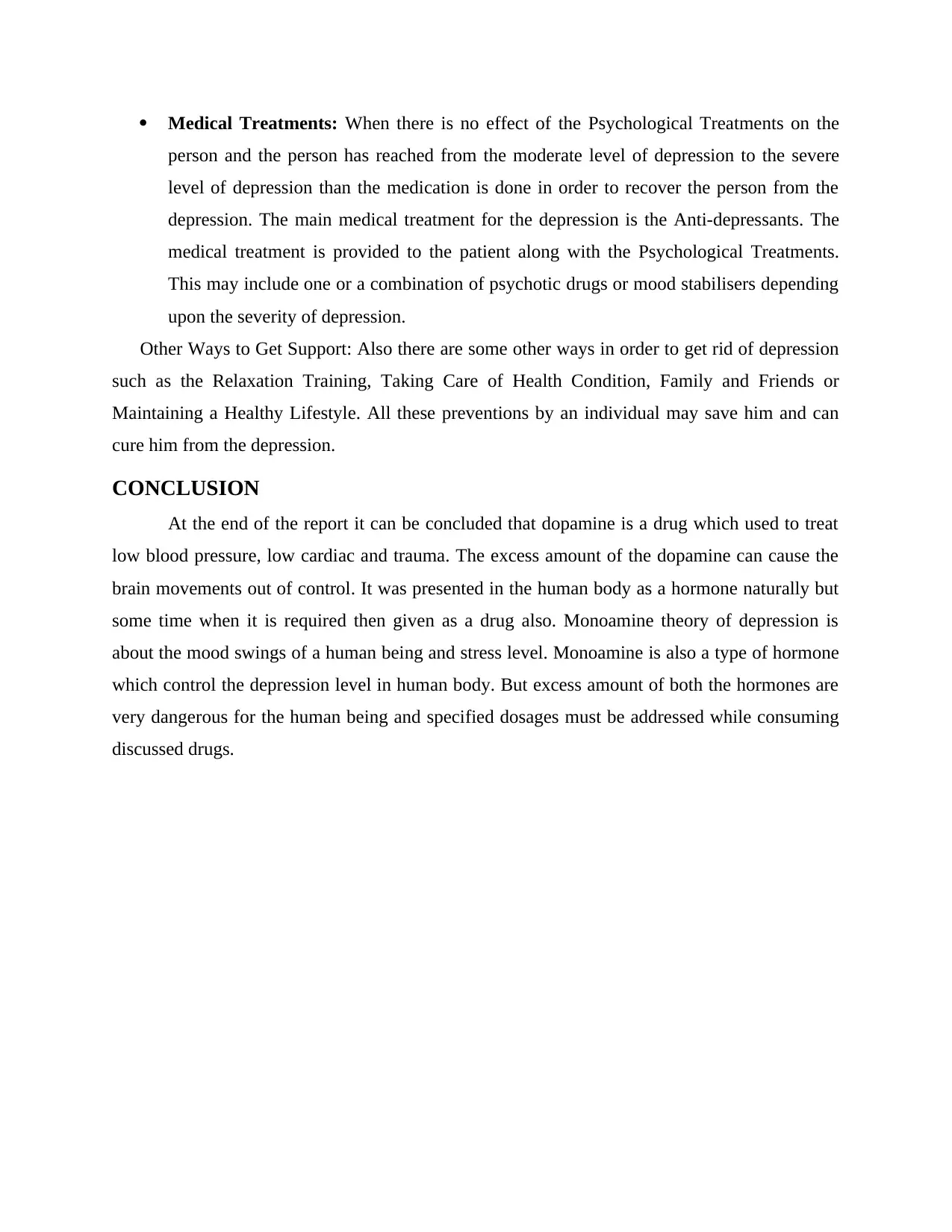
Medical Treatments: When there is no effect of the Psychological Treatments on the
person and the person has reached from the moderate level of depression to the severe
level of depression than the medication is done in order to recover the person from the
depression. The main medical treatment for the depression is the Anti-depressants. The
medical treatment is provided to the patient along with the Psychological Treatments.
This may include one or a combination of psychotic drugs or mood stabilisers depending
upon the severity of depression.
Other Ways to Get Support: Also there are some other ways in order to get rid of depression
such as the Relaxation Training, Taking Care of Health Condition, Family and Friends or
Maintaining a Healthy Lifestyle. All these preventions by an individual may save him and can
cure him from the depression.
CONCLUSION
At the end of the report it can be concluded that dopamine is a drug which used to treat
low blood pressure, low cardiac and trauma. The excess amount of the dopamine can cause the
brain movements out of control. It was presented in the human body as a hormone naturally but
some time when it is required then given as a drug also. Monoamine theory of depression is
about the mood swings of a human being and stress level. Monoamine is also a type of hormone
which control the depression level in human body. But excess amount of both the hormones are
very dangerous for the human being and specified dosages must be addressed while consuming
discussed drugs.
person and the person has reached from the moderate level of depression to the severe
level of depression than the medication is done in order to recover the person from the
depression. The main medical treatment for the depression is the Anti-depressants. The
medical treatment is provided to the patient along with the Psychological Treatments.
This may include one or a combination of psychotic drugs or mood stabilisers depending
upon the severity of depression.
Other Ways to Get Support: Also there are some other ways in order to get rid of depression
such as the Relaxation Training, Taking Care of Health Condition, Family and Friends or
Maintaining a Healthy Lifestyle. All these preventions by an individual may save him and can
cure him from the depression.
CONCLUSION
At the end of the report it can be concluded that dopamine is a drug which used to treat
low blood pressure, low cardiac and trauma. The excess amount of the dopamine can cause the
brain movements out of control. It was presented in the human body as a hormone naturally but
some time when it is required then given as a drug also. Monoamine theory of depression is
about the mood swings of a human being and stress level. Monoamine is also a type of hormone
which control the depression level in human body. But excess amount of both the hormones are
very dangerous for the human being and specified dosages must be addressed while consuming
discussed drugs.

REFERENCES
Books& Journals:
Albert, P.R., Benkelfat, C. and Descarries, L., 2012. The neurobiology of depression—revisiting
the serotonin hypothesis. I. Cellular and molecular mechanisms.
Alsiö, J., et. al., 2011. Enhanced sucrose and cocaine self-administration and cue-induced drug
seeking after loss of VGLUT2 in midbrain dopamine neurons in mice. Journal of
Neuroscience, 31(35). pp.12593-12603.
Duncan, J., Johnson, S. and Ou, X.M., 2012. Monoamine oxidases in major depressive disorder
and alcoholism. Drug discoveries & therapeutics, 6(3). pp.112-122.
Edwards, S. and Koob, G.F., 2013. Escalation of drug self-administration as a hallmark of
persistent addiction liability. Behavioural pharmacology.24.
Laje, G., and et.al., 2012. Brain-derived neurotrophic factor Val66Met polymorphism and
antidepressant efficacy of ketamine in depressed patients. Biological psychiatry. 72(11).
pp. e27-e28.
Mark, G.P., and et.al., 2011. Cholinergic modulation of mesolimbic dopamine function and
reward. Physiology & behaviour. 104(1). pp.76-81.
Massart, R., Mongeau, R. and Lanfumey, L., 2012. Beyond the monoaminergic hypothesis:
neuroplasticity and epigenetic changes in a transgenic mouse model of depression. Phil.
Trans. R. Soc. B. 367(1601). pp.2485-2494.
Mulinari, S., 2012. Monoamine theories of depression: historical impact on biomedical research.
Journal of the History of the Neurosciences. 21(4). pp.366-392.
Pickens, C.L., and et.al., 2011. Neurobiology of the incubation of drug craving. Trends in
neurosciences.34(8). pp.411-420.
Skibicka, K.P., and et.al., 2012. Role of ghrelin in food reward: impact of ghrelin on sucrose
self‐administration and mesolimbic dopamine and acetylcholine receptor gene
expression. Addiction biology. 17(1). pp.95-107.
Wise, R.A., 2013. Dual roles of dopamine in food and drug seeking: the drive-reward paradox.
Biological psychiatry .73(9). pp.819-826.
Online
DOPAMINE HYDROCHLORIDE INJECTION, USP. 2018. [Online]. Available
through:<https://www.rxlist.com/dopamine-drug.htm#dosage>.
Books& Journals:
Albert, P.R., Benkelfat, C. and Descarries, L., 2012. The neurobiology of depression—revisiting
the serotonin hypothesis. I. Cellular and molecular mechanisms.
Alsiö, J., et. al., 2011. Enhanced sucrose and cocaine self-administration and cue-induced drug
seeking after loss of VGLUT2 in midbrain dopamine neurons in mice. Journal of
Neuroscience, 31(35). pp.12593-12603.
Duncan, J., Johnson, S. and Ou, X.M., 2012. Monoamine oxidases in major depressive disorder
and alcoholism. Drug discoveries & therapeutics, 6(3). pp.112-122.
Edwards, S. and Koob, G.F., 2013. Escalation of drug self-administration as a hallmark of
persistent addiction liability. Behavioural pharmacology.24.
Laje, G., and et.al., 2012. Brain-derived neurotrophic factor Val66Met polymorphism and
antidepressant efficacy of ketamine in depressed patients. Biological psychiatry. 72(11).
pp. e27-e28.
Mark, G.P., and et.al., 2011. Cholinergic modulation of mesolimbic dopamine function and
reward. Physiology & behaviour. 104(1). pp.76-81.
Massart, R., Mongeau, R. and Lanfumey, L., 2012. Beyond the monoaminergic hypothesis:
neuroplasticity and epigenetic changes in a transgenic mouse model of depression. Phil.
Trans. R. Soc. B. 367(1601). pp.2485-2494.
Mulinari, S., 2012. Monoamine theories of depression: historical impact on biomedical research.
Journal of the History of the Neurosciences. 21(4). pp.366-392.
Pickens, C.L., and et.al., 2011. Neurobiology of the incubation of drug craving. Trends in
neurosciences.34(8). pp.411-420.
Skibicka, K.P., and et.al., 2012. Role of ghrelin in food reward: impact of ghrelin on sucrose
self‐administration and mesolimbic dopamine and acetylcholine receptor gene
expression. Addiction biology. 17(1). pp.95-107.
Wise, R.A., 2013. Dual roles of dopamine in food and drug seeking: the drive-reward paradox.
Biological psychiatry .73(9). pp.819-826.
Online
DOPAMINE HYDROCHLORIDE INJECTION, USP. 2018. [Online]. Available
through:<https://www.rxlist.com/dopamine-drug.htm#dosage>.
1 out of 12
Related Documents
Your All-in-One AI-Powered Toolkit for Academic Success.
+13062052269
info@desklib.com
Available 24*7 on WhatsApp / Email
![[object Object]](/_next/static/media/star-bottom.7253800d.svg)
Unlock your academic potential
© 2024 | Zucol Services PVT LTD | All rights reserved.





